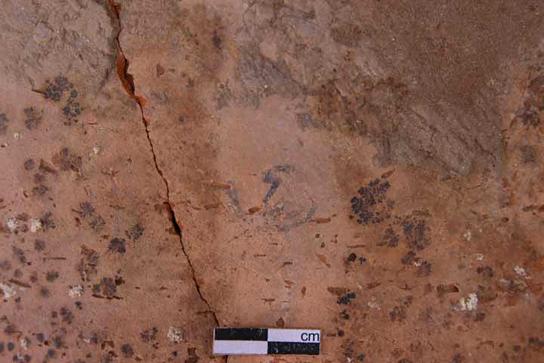Marie Millet / British Museum
The Amara West team is now beginning to finalise plans for its next excavation season, in January and February 2013. In recent months, we’ve been digitising our field documentation (drawings, plans, maps …), which has allowed us to reconstruct biographies for objects found during our excavations earlier this year. This work is shedding light on life at the town of Amara West, the principal administrative centre of Upper Nubia during the Ramesside Period, at the end of the second millennium BC.
One object in particular caught my attention: a large vessel (C4460) buried in the floor of house E13.8. This single object enables us to tell a chapter in the story of “House of Ramesses-ruler-of-Thebes”, as Amara West was called in ancient times.

A large vessel (C4460) found buried in the floor of house E13.8
House E13.8 was excavated last season by Tom Lyons and Shadia Abdu Rabu, between the enclosure wall and house E13.3. It was built over the remains of a production area with a kiln. Though this house was built over an empty, trapezoid-shaped space, it features all of the key elements of an Amara house: hearths, bread ovens, room with mastaba-bench.

Excavation at Amara West, 2012
In the back room, to the left of the door, we came across a large buried pot. Why was it there? Usually in archaeology we go back in time, because we are discovering the most recent part of a site and ‘peeling back’ the layers to find earlier remains. But with this object, we can tell the story from beginning to end.
We know that this very large jar was made on a potter’s wheel, as we can see wheel-marks on the interior surface. The exterior is a white colour. It’s made from Nile clay, which makes it difficult to distinguish whether it was produced in Egypt or in Upper Nubia: was it imported, or made locally at Amara West? Such pots are usually made from more specific Egyptian clay, ‘marl clay’, though in Abydos, examples made from Nile clay have been found with a white slip added to the exterior, to imitate pots made from marl clay.

Storage-jar, found at el-Amarna, Egypt, 1350 BC from the British Museum collection
Egyptologists call this kind of jar a ‘meat jar’, as ink labels found on them, especially in Amarna, state that meat was stored inside. Some jars from this site in the British Museum collection offer a good comparison with the newly-excavated material.
The Amara West pot bears a hieratic inscription, carefully conserved by Philip Kevin, saying it held cqw- (bread) loaves (thanks to Robert Demarée for the translation). So this jar was used to transport or store a number of loaves. At a later stage, it was then buried in the floor at the back of the house, possibly to keep food cool, a change in function we often see with this type of jar, both at Amara West and at Amarna. The archaeological stratigraphy suggests that it was buried during the 20th dynasty. As to what was stored inside; that’s a question for our archaeobotanists, Caroline Cartwright and Philippa Ryan, who will be studying the jar in due course.
Unfortunately, this jar lost its neck, perhaps while it was in use at the back of the house or when the area was refilled and the pot completely forgotten. The room was filled with rubble, containing doum-palm trees seeds, charcoal, wood, fish bones and ochre. The weight of these deposits caused the pot to collapse in on itself.
So this jar tells us its own life through its breaks, marks, shape, material and location in the archaeological stratigraphy. This provides us with a glimpse into the daily life of the inhabitants of Amara West.